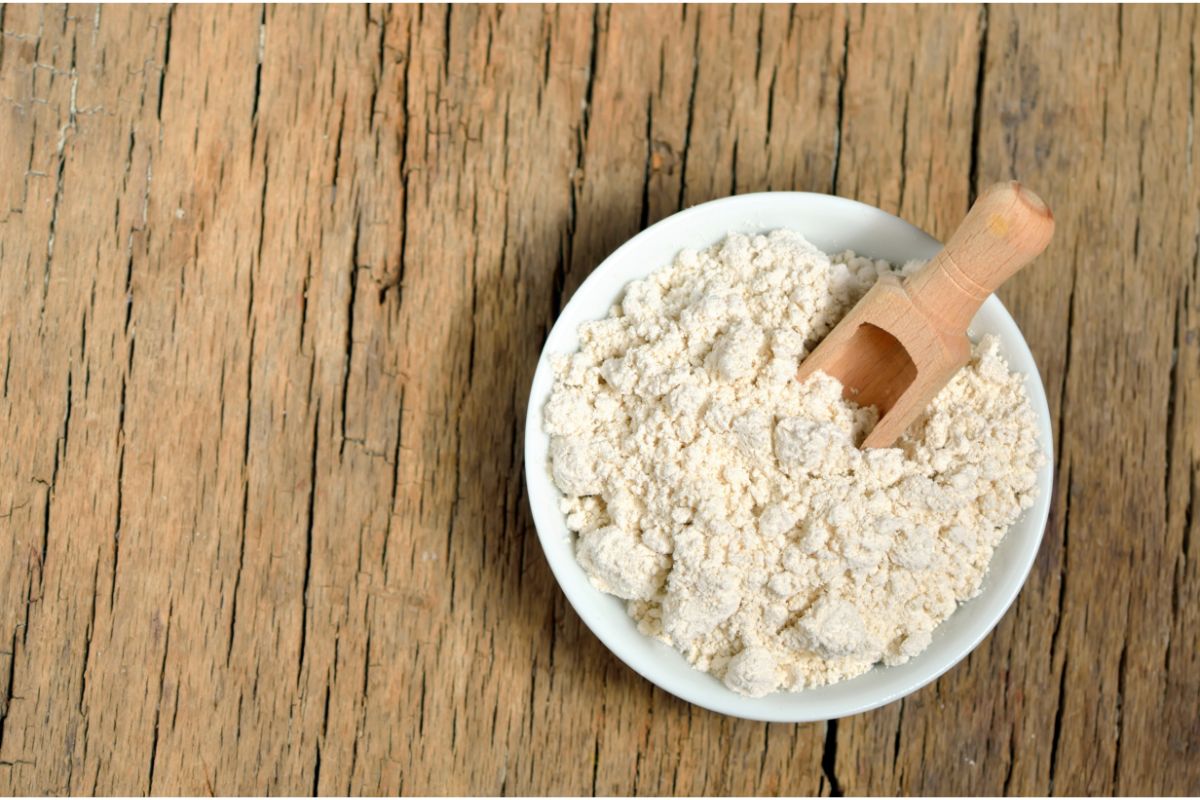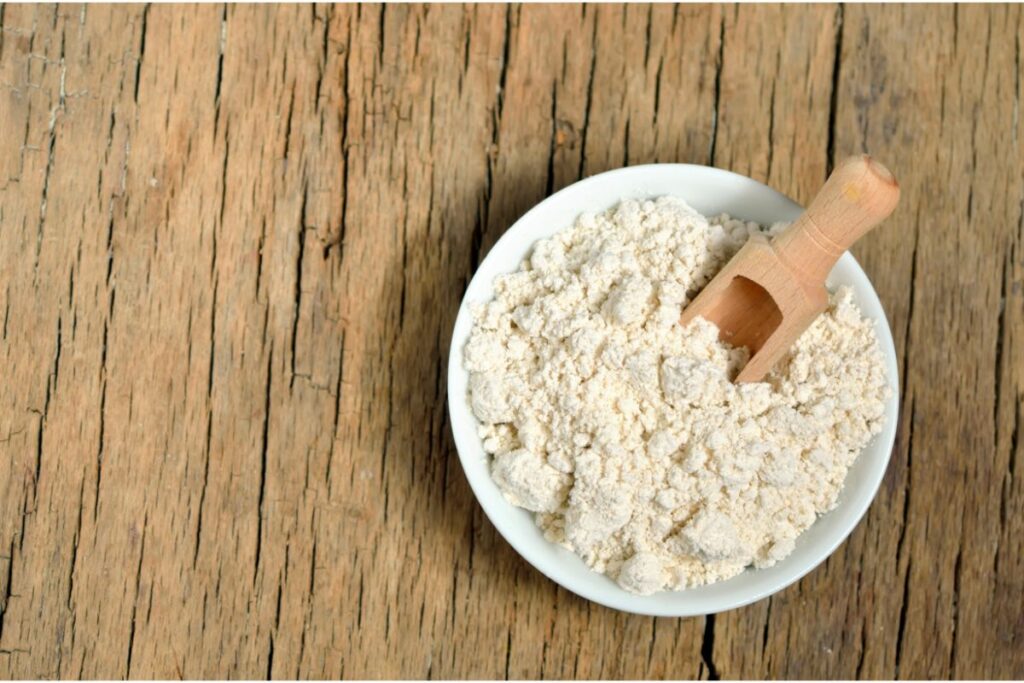If you’ve ever experienced dry, or irritated skin, your doctor may have suggested some at-home remedies to relieve the symptoms. One of these solutions is colloidal oatmeal.

Colloidal oatmeal isn’t meant to be eaten, but it’s meant to be applied topically on the skin. It is full of fats, vitamins, and minerals that help soothe and nourish the skin.
You’ll learn more about colloidal oatmeal in this article, including what it is, how you can use it, and how to make your own colloidal oatmeal treatment.
Colloidal Oatmeal: The Basics
Colloidal oatmeal has been used as a skin treatment for hundreds of years.
In the modern era, you’ll often find colloidal oatmeal inside toiletry products, including moisturizers, shaving creams, and body lotions.
Colloidal oatmeal is sourced from ground oats, turning the grain into a fine, delicate powder. It’s known as an emollient as it soothes and softens the skin so well.
The oatmeal contains lots of nourishing ingredients, like fats, minerals, and proteins, which have amazing effects on the skin.
Colloidal oatmeal also contains lots of antioxidants and anti-inflammatory substances which can soothe the skin.
Antioxidants are known to destroy free radicals, which are known to harm the body if they accumulate in high amounts.
Oxidative stress can lead to serious health conditions, including heart disease, diabetes, and cancer.
It can also cause skin conditions, such as dermatitis, as well as affect aging skin from a loss of moisture and elasticity.
Research has shown that colloidal oatmeal’s chemical properties can eliminate cytokines.
These are proteins that can damage the body. As they inhibit the cytokines, avenanthramides, which are chemicals within oat kernels, start preventing inflammatory effects from occurring.
Avenanthramides don’t just have amazing skin benefits, they are responsible for the heart-healthy benefits that come from eating oatmeal.
Colloidal Oatmeal Uses
Colloidal oatmeal is used to address many skin conditions and their effects, including dermatitis.
Dermatitis, also known as eczema, is a group of medical symptoms that lead to skin issues, including patchy, irritated, and itchy skin. Eczema has many causes, such as irritants, stress, and allergies.
Eczema usually affects children, but it can also affect adults. Colloidal oatmeal is often used in baths and lotions to treat the side effects. Skin side effects that have occurred after cancer radiation treatments can also be treated with colloidal oatmeal.
Colloidal oatmeal is also often used to treat xerosis. The symptoms of this condition are extremely dry skin.
Xerosis often occurs within the colder winter months, as well as older adults with aging skin. It can also show up after one has exposed themselves to harsh, potent chemicals. Some medications can also bring out xerosis within the skin.
Research has shown that people who experienced xerosis have noticed that their skin’s moisture level improved after using a colloidal oatmeal moisturizer.
Colloidal oatmeal can also help relieve itching symptoms from burns and chickenpox. However, in this case, the treatment is often used alongside other medications, like antihistamines to soothe the itching.
However, keep in mind that serious burns will need immediate medical care to prevent infections later. If severe burns aren’t treated well, this can lead to grave complications occurring, and in the gravest case, death.
Is Colloidal Oatmeal Safe To Use?

In most cases, colloidal oatmeal is safe to use. Some may worry about allergic reactions, but these are rare.
A 2012 study found that just 1% of 2,291 people experienced low irritation after wearing a colloidal oatmeal patch for a day. Most of the participants also reported consistent moisture levels for a fortnight after wearing it.
However, while allergic reactions are rare, people with oat allergies should avoid using colloidal oatmeal.
If you do experience unpleasant symptoms after using the oatmeal, like stinging, rashes, or irritation, stop using the oatmeal at once. Consult a doctor or medical professional for further advice.
How To Make Colloidal Oatmeal
While you can purchase colloidal oatmeal lotions and baths, making your treatment can save you a little money. It’s also very easy to do!
Follow the steps below to make colloidal oatmeal.
- Fill a blender, coffee grinder, or food processor with some uncooked, whole oatmeal.
- Pulse the blender until the oatmeal turns into a fine powder.
- Test if the oatmeal is ground down enough by mixing a tablespoon of the powder into a pint of water. If the water turns a milky white color, the oatmeal has been ground down enough. If the water doesn’t change color or the oatmeal sinks to the bottom, the oatmeal will need more grinding.
If you’d like to draw a colloidal oatmeal bath, fill your bathtub with lukewarm water and add a cup of the oatmeal powder to it. Soak in the water for 15 minutes.
Make sure the water is warm, not too hot. Hot water can dry out the skin further, leading to irritation later on.
Once you’ve had your bath, air dry your body, as towel drying may remove some of the oatmeal’s moisture. Apply a scent-free moisturizer that’s suitable for sensitive skin.
Colloidal oatmeal baths are suitable for children and adults, as long as they don’t have oatmeal allergies.
If you are drawing a colloidal oatmeal bath for children, you need to be certain that the water is warm, never hot.
A suitable water temperature for children and infants is roughly 100°F. If the bath is for a baby, you won’t need as much oatmeal powder. Use around ⅓ of a cup of powder instead.
If the baby hasn’t had an oatmeal bath before, carry out a patch test to be sure they aren’t allergic.
Create a mixture of water and colloidal oatmeal powder. Apply the substance to a small area of the skin, like the back of the hand or the forearm. Wait for 15 minutes then rinse off, looking out for any allergic signs, like irritation or redness.
Final Thoughts
Throughout history, colloidal oatmeal has been used to soothe irritated, sore, and dry skin. It’s made by grinding down oat grains and adding the powder to lotions, creams, and baths.
You can purchase colloidal oatmeal products, but it’s just as easy to make your own at home and add it to your bathwater.
Remember that while allergic reactions are rare, avoid colloidal oatmeal at all costs if you or your children have an oatmeal allergy. If you aren’t sure about whether you are allergic or not, carry out a patch test before using it.








